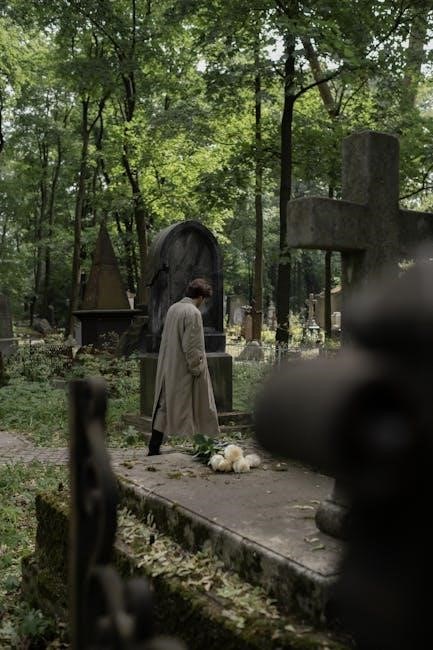
dead men’s path pdf
Chinua Achebe, a renowned Nigerian author, wrote “Dead Men’s Path” in 1953, exploring cultural conflict in a colonial Nigerian village. The story centers on Michael Obi, a modernizing headmaster who clashes with tradition, symbolized by an ancient footpath. Achebe’s work highlights postcolonial themes, offering a critique of colonialism’s impact on African society. His narrative style blends Igbo culture with English, reflecting his dual heritage. The story is widely studied, emphasizing the tension between progress and tradition, making it a seminal work in postcolonial literature.
Overview of Chinua Achebe’s Work and Significance
Chinua Achebe, a towering figure in African literature, is best known for his nuanced exploration of colonialism, cultural identity, and societal change. His works, such as Things Fall Apart, critique colonialism’s disruptive impact on African societies. Achebe’s writing often blends traditional Igbo culture with modern English, reflecting his dual heritage. His narratives highlight the complexities of cultural conflict and the resilience of African traditions. Achebe’s significance lies in his ability to articulate the African experience, making him a pioneer of postcolonial literature and a global voice for cultural understanding and preservation.
Background of the Short Story “Dead Men’s Path”
“Dead Men’s Path,” written by Chinua Achebe in 1953, is a short story set in a Nigerian village during the colonial period. It revolves around Michael Obi, a young, reform-minded headmaster tasked with modernizing the underperforming Ndume Central School. The story explores the tension between tradition and modernity as Obi confronts the village’s ancestral practices, particularly an ancient footpath used for religious purposes. Achebe’s narrative reflects the broader cultural and historical context of postcolonial Nigeria, offering insights into the complexities of change and tradition in African societies.
Plot Summary of “Dead Men’s Path”
Michael Obi, a young headmaster, modernizes Ndume Central School, clashing with villagers over an ancient footpath. His refusal to respect tradition leads to conflict and tragic consequences.
The Appointment of Michael Obi as Headmaster
Michael Obi’s appointment as headmaster of Ndume Central School in 1949 marked a turning point for the institution. The Mission authorities sought a young, energetic leader to modernize the backward school. Obi accepted the role enthusiastically, determined to bring progress and high standards to the community. His wife, Nancy, supported him in transforming the school, focusing on academic excellence and beautifying the grounds. Their efforts aimed to elevate the school’s reputation and improve education for the village children.
Modernization Efforts and the School’s Transformation
Michael Obi and his wife Nancy undertook significant modernization efforts at Ndume Central School. They beautified the grounds with vibrant hibiscus and allamanda hedges, creating a stark contrast to the surrounding wild bushes. Obi enforced high teaching standards, aiming to elevate the school’s reputation. Their efforts transformed the once-neglected institution into a symbol of progress, reflecting Obi’s vision of a modernized future. These changes, however, soon led to unintended conflicts with the village’s traditional practices, setting the stage for deeper cultural tensions.
The Discovery of the Ancient Footpath

The ancient footpath, used by villagers for generations, was a sacred route believed to connect the living to their ancestors. Its discovery by Michael Obi led to immediate conflict, as he viewed it as outdated and obstructive to his modernization plans. Obi, determined to block the path, erected barriers with barbed wire, disregarding its cultural significance. This act symbolized his rejection of tradition, igniting tension between him and the villagers, who saw the footpath as a vital link to their heritage and spiritual practices.
The Conflict Between Tradition and Modernity
The core of “Dead Men’s Path” lies in the clash between tradition and modernity. Michael Obi embodies modernity, striving to reform the school and discard outdated customs. The villagers, however, cling to their ancestral practices, viewing the footpath as a sacred connection to their past. Obi’s refusal to respect this tradition sparks a deep-seated conflict, highlighting the tension between progress and cultural preservation. This struggle reflects broader postcolonial themes, as African societies grappled with the imposition of Western values and the erosion of indigenous traditions during colonial rule.
The Climax and Resolution of the Story
The climax arises when Michael Obi, determined to modernize, blocks the ancestral footpath, disregarding the village’s traditions. Tension escalates as the villagers, led by the priest, protest this desecration. Tragedy strikes when an old woman dies after being denied access to the path, intensifying the conflict. The story resolves with Obi’s dismissal, as the villagers reclaim their traditions. This outcome underscores the consequences of arrogance and the enduring power of cultural heritage, leaving a poignant reflection on the balance between progress and preserving the past.

Themes in “Dead Men’s Path”
The story explores themes of tradition vs. modernity, colonialism’s impact, and hubris. It highlights cultural conflict, the clash of old and new values, and personal arrogance.
Tradition vs. Modernity
The story revolves around the clash between tradition and modernity, symbolized by the ancient footpath and Michael Obi’s progressive ideals. Obi, representing modernity, seeks to transform the school and disregard the footpath, while the villagers, embodying tradition, insist on preserving their ancestral customs. This conflict highlights the tension between cultural heritage and colonial-induced modernization. Achebe critiques the arrogance of imposing modernity without understanding tradition, illustrating the destructive consequences of ignoring cultural roots. The footpath becomes a symbol of the enduring power of tradition in a rapidly changing world;

The Impact of Colonialism on African Society
Colonialism profoundly shaped African societies, as seen in “Dead Men’s Path.” Michael Obi’s appointment as headmaster reflects the colonial system’s influence, where Western-educated elites were tasked with modernizing traditional communities. Obi’s disregard for the ancestral footpath symbolizes the broader colonial mindset that often dismissed indigenous traditions as backward. Achebe critiques this dynamic, illustrating how colonialism fostered a disconnect between educated Africans and their cultural roots. The story highlights the tension between imposed modernity and enduring traditional values, revealing the complex legacy of colonialism in postcolonial Africa.
Hubris and the Consequences of Arrogance
Michael Obi’s hubris is central to the story, as his arrogance drives his decisions. His ambition to modernize the school leads him to dismiss the villagers’ traditions, epitomized by the ancient footpath. Obi’s refusal to respect the path, despite the villagers’ pleas, showcases his pride and disregard for cultural heritage. His downfall stems from this arrogance, as the villagers retaliate, leading to tragic consequences. Achebe uses Obi’s character to critique the dangers of unchecked pride and the importance of respecting tradition, highlighting how arrogance can undermine even noble intentions.
Symbols and Symbolism in the Story
Symbols in “Dead Men’s Path” represent cultural and spiritual elements. The footpath symbolizes tradition and heritage, while the school embodies modernity and change. The old woman and priest signify the village’s spiritual connection, highlighting the clash between old and new values.
The Significance of the Footpath
The footpath in “Dead Men’s Path” is a potent symbol of tradition and cultural heritage. It serves as a sacred route for the villagers, connecting their ancestors’ burial ground to the living, ensuring spiritual continuity. The path represents the villagers’ deep-rooted beliefs and practices passed down through generations. Michael Obi’s decision to block it signifies his disregard for tradition, highlighting the conflict between modernity and cultural preservation. The footpath embodies the village’s identity and spiritual essence, making its destruction a profound loss of cultural continuity.
The School as a Symbol of Modernity
The school in “Dead Men’s Path” symbolizes modernity and progress under Michael Obi’s leadership. Obi transforms the once-neglected institution by beautifying the grounds, planting vibrant hedges, and enforcing high academic standards. The school’s modernization contrasts sharply with the surrounding village, representing Obi’s vision of a progressive future. However, this transformation alienates the villagers, who view the school’s changes as a disregard for their traditions. The school becomes a physical and ideological space where modernity clashes with cultural heritage, highlighting the tensions of colonial influence.
The Old Woman and the Village Priest
The old woman and the village priest embody tradition and cultural heritage in “Dead Men’s Path.” The old woman’s defiance in crossing the school grounds symbolizes the villagers’ deep connection to their ancestral path. The priest, representing spiritual authority, pleads with Obi to reopen the footpath, emphasizing its cultural significance. Their actions highlight the villagers’ belief in honoring the past, contrasting with Obi’s modernizing ideals. The priest’s visit and the old woman’s persistence underscore the community’s resistance to change, illustrating the clash between tradition and progress. Their roles amplify the story’s central conflict.

The Title: “Dead Men’s Path”
The title reflects the ancestral footpath’s significance, symbolizing tradition and cultural heritage. Published in 1953, it highlights the conflict between modernity and tradition in a Nigerian village.
Interpretation and Relevance to the Story
The title “Dead Men’s Path” symbolizes the ancestral footpath, representing tradition and cultural continuity. It emphasizes the conflict between modernity and tradition, as Michael Obi’s actions disrupt the village’s heritage. The footpath serves as a connection to the past, highlighting the consequences of ignoring cultural practices. Achebe uses the title to underscore the clash between progress and tradition, reflecting broader postcolonial themes of cultural identity and the impact of colonialism on African societies. The story remains relevant for its universal themes of tradition vs. modernity.
Genre and Style
Chinua Achebe’s “Dead Men’s Path” falls under postcolonial fiction, blending cultural critique with a clear, straightforward narrative style to explore themes of tradition and modernity.
Postcolonial Fiction and Its Elements
Chinua Achebe’s “Dead Men’s Path” is a quintessential example of postcolonial fiction, exploring the cultural and ideological conflicts arising from colonialism. The story delves into the tension between traditional African practices and Western modernity, as embodied by Michael Obi’s efforts to modernize the school. Achebe critiques colonialism’s disruptive influence on indigenous cultures, highlighting themes of cultural erasure and the commodification of tradition. Through Obi’s hubris, Achebe examines the complexities of identity and power dynamics in a colonized society, offering a nuanced critique of colonial ideologies and their lasting impact.
Achebe’s Narrative Style and Language Use
Chinua Achebe’s narrative style in “Dead Men’s Path” is marked by simplicity and clarity, yet it carries profound depth. He employs a direct prose that reflects his Igbo heritage while blending it with English, creating a unique linguistic landscape. Achebe’s use of dialogue highlights cultural tensions, such as the confrontation between Michael Obi and the village priest. His language often mirrors the characters’ backgrounds, with Obi’s modernized speech contrasting with the villagers’ traditional expressions. This duality in language underscores the story’s central theme of cultural clash and identity.

Reception and Impact
“Dead Men’s Path” is celebrated for its profound exploration of cultural conflict, making it a cornerstone in postcolonial literature. Widely studied in schools, it influences discussions on tradition, modernity, and colonialism, leaving a lasting educational and literary impact.
Initial Reception and Critical Reviews
Upon its 1953 release, “Dead Men’s Path” received critical acclaim for its nuanced portrayal of cultural conflict. Reviewers praised Achebe’s ability to weave traditional Igbo elements into a modern narrative, highlighting the story’s universal themes. The character of Michael Obi was seen as a symbol of colonial influence, with his actions sparking debates on progress versus tradition. The story’s concise yet powerful structure was noted for its effectiveness in conveying complex societal issues. This initial praise established Achebe as a prominent voice in African literature.
Lasting Legacy and Educational Use
“Dead Men’s Path” has become a cornerstone in literary curriculums worldwide, celebrated for its profound exploration of cultural identity and colonialism. Its concise yet impactful narrative makes it a favorite in educational settings, sparking discussions on tradition, modernity, and societal change. The story’s accessibility and depth have solidified its place in postcolonial studies, with universities and schools incorporating it to teach critical thinking and cultural sensitivity. Its enduring relevance continues to inspire new generations, ensuring Achebe’s legacy as a pivotal figure in world literature.

Availability and Download Options
“Dead Men’s Path” is widely available as a PDF, Word Doc, or text file for free download or online reading. Platforms like GRIN VERLAG and Scribd offer access, while educational sites provide it as part of postcolonial literature collections. The story is included in Chinua Achebe’s “Girls at War and Other Stories,” making it easy to find and study digitally.
Downloading “Dead Men’s Path” as a PDF
Downloading “Dead Men’s Path” as a PDF is straightforward. The story is available on platforms like Scribd and Academia.edu, where users can download it free of charge. It is also included in Chinua Achebe’s collection, Girls at War and Other Stories, which can be downloaded in PDF format. Additionally, educational websites and repositories offer the PDF for free, making it easily accessible for academic purposes. Some platforms may require registration, but the process is simple and quick, ensuring readers can access the story conveniently.
Free Resources and Online Availability
“Dead Men’s Path” is widely available as a free PDF online. Platforms like Scribd, Academia.edu, and Google Drive offer downloadable versions. It is also accessible through educational websites and online libraries. The story is often included in collections of Chinua Achebe’s works, such as Girls at War and Other Stories. Many websites provide free access without registration, making it easily accessible for students and readers. Its popularity in academic circles ensures its availability across multiple online platforms for convenient reading and study.

